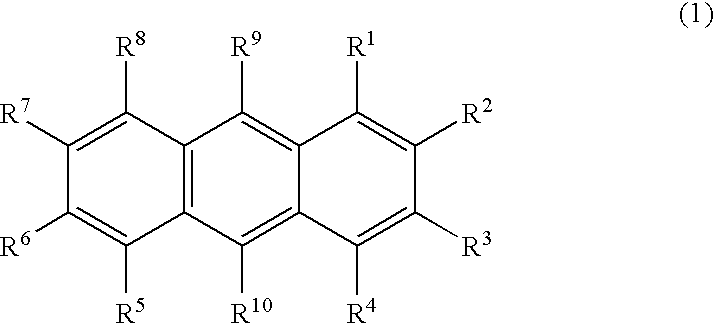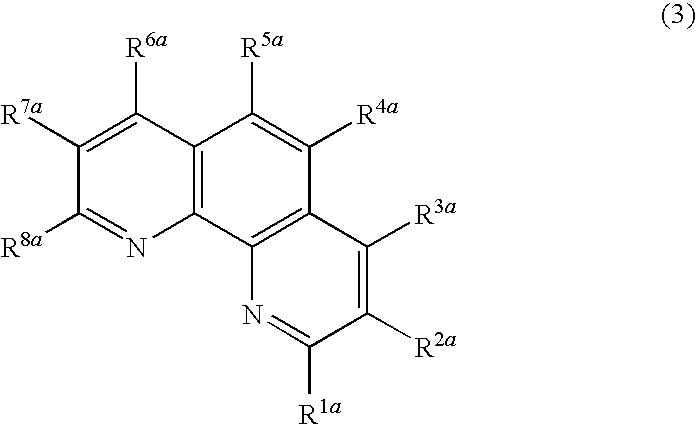Nitrogenous heterocyclic derivative and organic electroluminescence device making use of the same
a technology of nitrogen heterocyclic derivatives and organic electroluminescence devices, which is applied in the direction of luminescent compositions, thermoelectric devices, organic chemistry, etc., can solve the problems of not being put to practical use, notably deteriorating characteristics, and short durability, so as to improve the current efficiency and enhance the light-emitting luminance
- Summary
- Abstract
- Description
- Claims
- Application Information
AI Technical Summary
Benefits of technology
Problems solved by technology
Method used
Image
Examples
synthetic example 1
(1-1) Synthesis of Intermediate 1
[0110]
[0111]A 500 mL three neck flask was charged with 4.8 g (24 mmol) of 4-bromoacetophenone, 10 g (29 mmol) of 10-naphthalene-2-yl-anthracene-9-boronic acid, 0.55 g (0.5 mmol) of tetrakistriphenylphosphinepalladium (0), 100 mL of 1,2-dimethoxyethane and 45 mL of a 2M sodium carbonate aqueous solution under argon flow, and the mixture was heated and refluxed for 8 hours. After finishing the reaction, the organic layer was washed with water and dried on magnesium sulfate, and the solvent was removed by distillation by means of a rotary evaporator. The resulting crude crystal was recrystallized from ethanol to obtain 8.5 g (white crystal, yield: 70%) of the targeted intermediate 1.
(1-2) Synthesis of Compound (1)
[0112]
[0113]The intermediate 1 4.0 g (9.5 mmol), 8-aminoquinoline-7-carboaldehyde 1.7 g (9.9 mmol) and ethanol 40 mL were added and dissolved by heating under argon atmosphere. A saturated potassium hydroxide ethanol solution 10 mL was dropwise...
synthetic example 2
(2-1) Synthesis of Intermediate 2
[0114]
[0115]An intermediate 2 was obtained by carrying out the same operation, except that in Synthetic Example 1 (1-1), 3-bromoacetophenone was used in place of 4-bromoacetophenone. Yield: 60%.
(2-2) Synthesis of Compound (2)
[0116]
[0117]A compound (2) was obtained by carrying out the same operation, except that in Synthetic Example 2 (1-2), the intermediate 2 was used in place of the intermediate 1. This product was measured by FD-MS (field desorption mass spectrum), whereby it was identified as the compound (2). Yield: 50%.
example 1
Production of Organic EL Device in which the Compound of the Present Invention is Used in an Electron Injecting Layer
[0118]A glass substrate (manufactured by Geomatech Co., Ltd.) of 25 mm×75 mm×1.1 mm thickness equipped with an ITO transparent electrode (anode) was subjected to supersonic wave washing in isopropyl alcohol for 5 minutes and then to UV ozone washing for 30 minutes. After washed, the glass substrate equipped with an ITO transparent electrode line was loaded in a substrate holder of a vacuum vapor deposition apparatus, and a N,N′-bis(N,N′-diphenyl-4-aminophenyl)-N,N-diphenyl-4,4′-diamino-1,1′-biphenyl film (hereinafter abbreviated as a “TPD232 film”) having a film thickness of 60 nm was first formed on a face of a side at which the transparent electrode line was formed so that it covers the transparent electrode described above. This TPD232 film functions as a hole injecting layer. After forming the TPD232 film, a 4,4′-bis[N-(1-naphthyl)-N-phenylamino]biphenyl film (her...
PUM
| Property | Measurement | Unit |
|---|---|---|
| transmittance | aaaaa | aaaaa |
| work function | aaaaa | aaaaa |
| transmittance | aaaaa | aaaaa |
Abstract
Description
Claims
Application Information
 Login to View More
Login to View More - R&D
- Intellectual Property
- Life Sciences
- Materials
- Tech Scout
- Unparalleled Data Quality
- Higher Quality Content
- 60% Fewer Hallucinations
Browse by: Latest US Patents, China's latest patents, Technical Efficacy Thesaurus, Application Domain, Technology Topic, Popular Technical Reports.
© 2025 PatSnap. All rights reserved.Legal|Privacy policy|Modern Slavery Act Transparency Statement|Sitemap|About US| Contact US: help@patsnap.com



